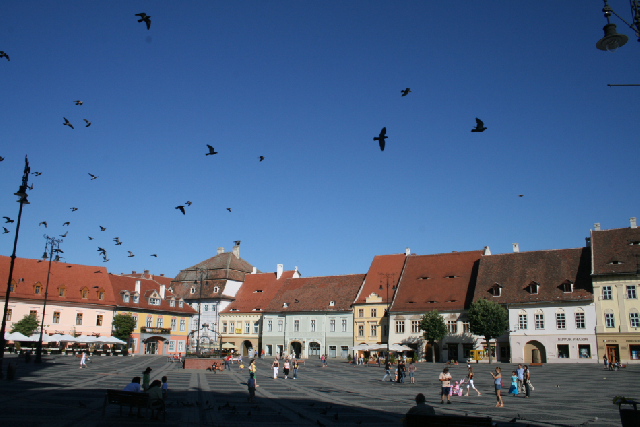Discovering Sibiu County
A European Cultural Capital in 2007, Sibiu, the capital city of the county with the same name, is one of Romanias most important cultural centers.

România Internațional, 16.10.2014, 14:22
Sibiu was the largest and wealthiest of the seven walled citadels built in the 12th century by German settlers known as Transylvanian Saxons. Sibiu makes an ideal base for the exploration of the nearby countryside and villages which display an interesting mixture of Saxon and Romanian traditions. Gyongyi Takacs, a project coordinator with the Sibiu Tourist Association, tells us why Sibiu is worth visiting:
Gyongyi Takacs: “Tourist routes in the Sibiu county’s five ethno-geographic regions are numerous and interesting. We invite you on the Cheese Road in the southern part of the county, to the famous Margininea Sibiului. Located at the foothills of the Cindrel Mountains, a half-hour drive from Sibiu, this region is considered one of Transylvania’s best-preserved ethnographic areas. On September 19, shepherds bring sheep flocks down from the mountain and that’s something worth seeing. Tourists are also invited to take walks through fruit orchards, and admire the breathtaking landscape of the Cindrel Mountains. Visiting the Museum of Icons on Glass founded by Father Zosim Oancea in Sibiel, or the Collection of pastoral objects in Jina is another excellent option. We also have an attractive offer for those who are into cycling. Bicycle lovers are invited to try out the mountain cyclopaths leading to the heart of the Cindrel Mountains. Make sure you don’t leave the Sibiu area without spending at least one day in the fresh air of the Paltinis resort. Don’t forget to get your fair share of adrenaline in the Arka Adventure Park.”
Following the course of the Olt river, tourists can visit the baron von Brukenthal’s Palace and garden in Avrig and the Cistercian Abbey in Carta. Taking the cable car up the Transfagarasan route, all the way up the to the Balea Waterfalls, offers visitors a wonderful view of one of Romania’s most spectacular roads.
The region of Sibiu is also famous for its wonderful cuisine. With details on that, here is Gyongyi Takacs again:
Gyongyi Takacs: ”Memorable food festivals are held along the Hartibaci river. Make sure you book an organic picnic with traditional food in the middle of the scenic landscape of the Fagaras Mountains. It’s also worth visiting the Old Mill in Hosman to have a taste of Sibiu’s traditional bakery. Then go towards Agnita to taste a dessert inspired from the Saxon cuisine”.
On the Tarnave Valley, also known as the Fortifications road, the charm of the fortified churches is enhanced by the colors of the autumn scenery, typical of Transylvania.
The city of Sibiu, first documented in 1911, has a strong Medieval character. No less than four rings of fortifications were built here between the 13th and the 16th centuries. The old center of the city, consisting of three historic squares – Huet, the Grand Plaza and the Little Plaza – are the most important Medieval sites in Romania. The Grand Square is a square of buildings bearing the crests of the most important families of the 15th to 18th century. The most important tourist spot here is the palace of Baron Samuel von Brukenthal, the first arts museum open to the Romanian public, as early as 1817. Built in the Baroque style between 1778 and 1788, the palace was the baron’s home. If you go to Sibiu on your own, you can find plenty of tourism information centers, some run by the City Hall, some by private companies. These centers offer all the information that tourists need, in English, German, Spanish and French. If you want to visit the city in an organized tour, there are plenty of opportunities too. Here is Gyongyi Takacs back at the microphone:
Gyongyi Takacs: “You can opt for a complex tour, with food tasting at the Tower of Butchers and accommodation at the Axente Sever fortified church. Don’t leave before you also attend a wine tasting session at the Traube wine cellar in the historic center, or without relaxing at the Bazna spa. In the city of Sibiu, autumn comes with a rich cultural offer: the opening of the theatre season at the Radu Stanca Theater, the Sibiu Jazz Festival, in its 46th edition between October 23 and 26, continuing with the Mozaic Jazz Festival between November 13 and 16. Between November 15 and 17, you can attend the Festival of Traditional Choirs in Saliste. You can also visit the ASTRA Open Air Museum for a bit of history.”
Hoping that we have told you all about the importance of Sibiu as a tourist site, it’s your turn now to contact your travel agent and book a trip there.






























